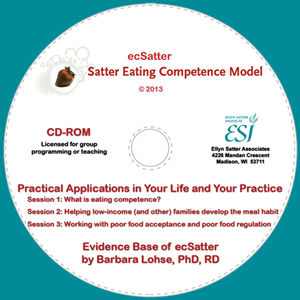

Family Meals Focus
The Ellyn Satter Institute Newsletter
Family meals: Let’s be realistic
by Ellyn Satter, Registered Dietitian and Family Therapist
To get the meal habit, start with what you eat now, and round up the family to eat together. For you to keep up the day-in-day-out effort of having meals, you have to enjoy the food. When nutritional shoulds and oughts get in the way, it complicates family meals to the point where you simply may not be able to cope. Stay realistic, and keep in mind that people who eat regular meals do best nutritionally, with regulating their food intake, and with maintaining stable body weight.
No time to cook a fancy meal
Clio role-plays a belligerent mother of toddlers through teens. She comes to my nutrition office expecting me to give her “the spiel about what to eat. Honestly, I get it! Eat more fruits and vegetables, don’t eat so much fat, don’t eat so much sugar.” I reassure her, “I am more inclined to try to interest you in having family meals.” Were they having family meals? “Only in the most loosely defined sense of the term.”We establish the fact that she doesn’t have time for “roast chicken and potatoes and vegetables and all of that.” As to what they do eat? “Probably something you wouldn’t be so keen on.” With a little encouragement, she owns up to chicken nuggets and French fries. I reassure her about the nutritional value of those foods, then say that the difference is structure: rounding up the family to share the same food at the same time. Another, even more important difference: feeling good about what she provides. Clio perks up and seems interested, she knows what parents already know: meals are important, and she felt bad that she can’t manage to have them. Realistic food goals make meals a possibility. But I still send her home to think about it. We part amiably. She needs to have a chance to decide if this is right for her and her family, not just do it because I persuade her. After a few weeks she is back, and we start with the how rather than the what of family meals.
People naturally learn and grow
Maintain structure – round up the family to share the same food at the same time; and feel good about what you provide.
Clio didn’t need to be persuaded. Before long, she found that sitting down and paying attention left her bored with the “same-old, same-old” food, which stimulated her to add variety. She added on broccoli, then made the mistake of trying to get her kids and herself to eat it. Which allowed her to appreciate being introduced to the division of responsibility in feeding. We also discussed how she can sneak up on vegetables and learn to like them. Clio may get to the point where she plans meals. She may not. But she mustn’t get caught in the food rules or it will spoil meals.
Getting the meal habit takes time
The progression Clio and worked through is Mastering Meals Step By Step. This sequence works great in groups, as well. Ask people which step describes their meals, endorse whatever level they are at, and keep the emphasis on structure rather than on food selection. Then let them learn from each other.
Mealtime structure is critical.
Explore
To see how Ellyn Satter turns a confrontation with a belligerent mother into friendly nutrition education, see the Satter Eating Competence Model Webcast Series on CD.
Related issues of Family Meals Focus
- Family meals are essential
- Family-style meals
- Family meals in restaurants
- Family meals mean love and security
- Family meals: Getting the meal habit

